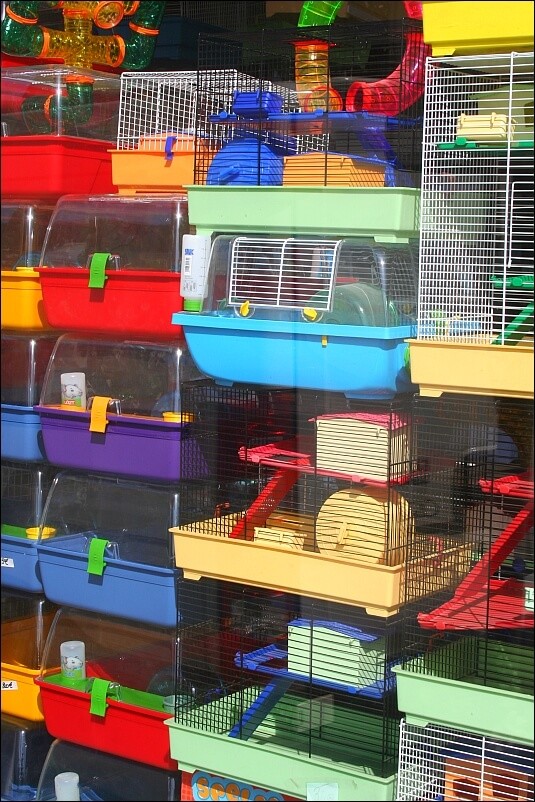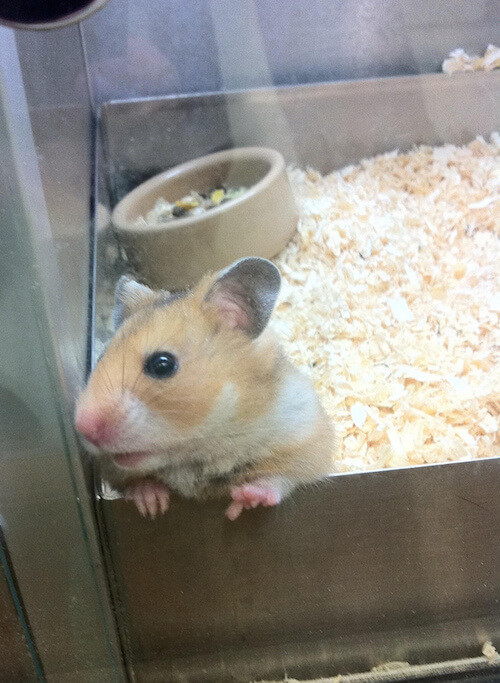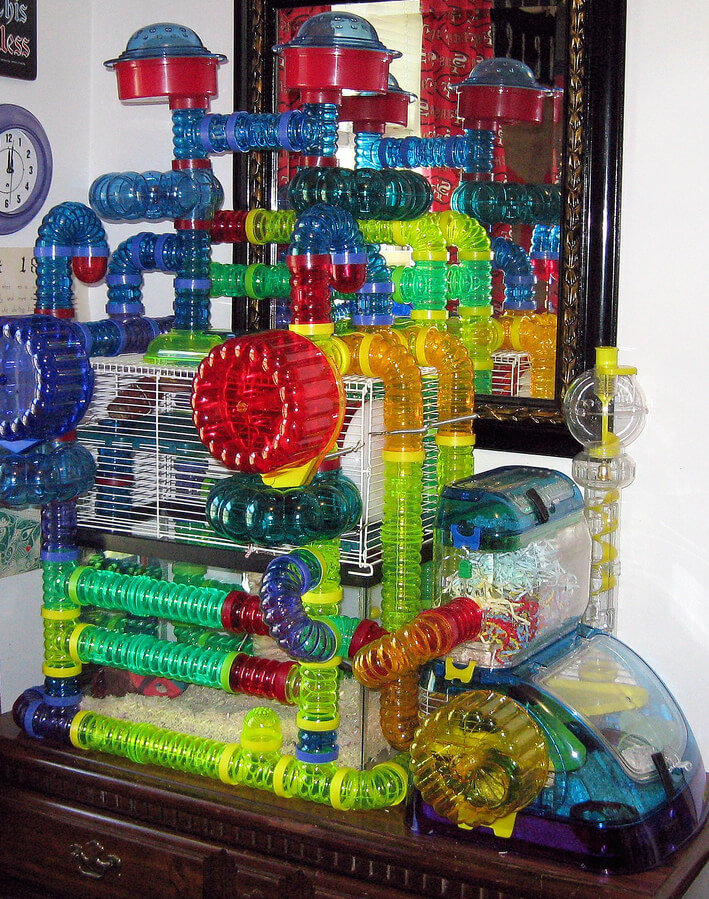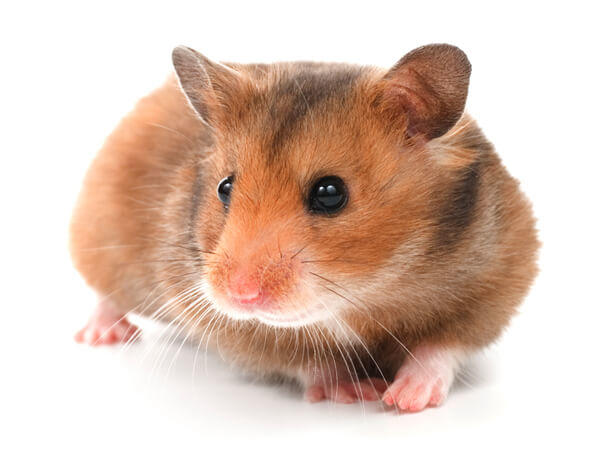Hamster Cages and Habitat Options
Selecting the proper hamster cage for your pet is almost as important as selecting your hamster itself. The habitat option you ultimately chose will be the place where your little friend will spend the majority of its life. In order to call this a good home, however, you must first make it as comfortable as possible.
Do you have a fun hamster setup? Share a photo with us and we will post it here. Contact Us

You don’t want your little pet to always be on guard or stir crazy from an inadequate habitat. Explore the following pros and cons of all the options that are available.
A traditional hamster cage is a metal wire cage typically made out of galvanized steel. Due to the true nature of hamsters, any bars that are coated in rubber or plastic will eventually be gnawed through exposing the cheap metal inside. This leads to a rusty compromised structure.
Jump to:
Plastic as a building material for a hamster habitat is not an ideal solution unless it’s a strong plastic with pieces that can not be gnawed on. Pet stores offer a lot of fun and creative options for plastic cages. Two manufacturers that offer great products include Habitrail and CritterTrail.
Jump to:
A glass aquarium offers the best option if you want a clear view of all the activity inside your hamster’s home. With solid walls an aquarium will contain more of the smells that come with owning a furry little creature than any other habitat options. Some owners buy a cage extension top to create levels.
Jump to:
The minimum cage size for one hamster is 12″ x 15″ x 12″ tall or (30 x38 x 30cm). Even at this size, your hamster can become bored and restless which is not fair to it. By building upwards and creating levels in your hamster cage, you can create more square footage within a confined space.
Jump to:
Wire Cage
The most common, readily available and most economical hamster cage at most pet stores is a traditional wire cage. These cages typically consist of wire bar sides and top, a small metal wire door and a plastic bottom base. Pet stores offer a wide range of sizes from very small to rather large.
Just because a pet store offer these smaller sized options, it doesn’t mean they are suitable for any hamster. The absolute minimum cage size for one hamster should be 12″ x 15″ x 12″ inches high (30 x38 x 30cm). If it looks smaller than a five gallon fish tank, it’s too small. Additionally, the wire bars should be spaced no more than 4/8 inches (1.3cm) apart for a Syrian hamster and 3/16 of an inch (.5cm) for dwarf size hamsters.
Galvanized Steel
The best building material for a wire hamster cage is galvanized steel. This type of metal is corrosive resistant, won’t rust, and therefore won’t fall apart if a hamster gnaws on the bars. Cages that have plastic or rubber coatings usually have cheap metals inside and when a hamster chews through the casing, the unsightly exposed bars can rust and fall apart.
The Benefits of Wire
A wire cage has several benefits over other hamster habitats. For starters they are more reasonably priced other hamster cage options. Secondly, with the openness of the wire bar sides, maximum air circulation allows the cage to always have fresh air. Lastly, additional levels can easily be added and secured to the crossbars and a cage door adapter can always be added to allow for a tunnel to connect to another hamster habitat.

Drawbacks of These Cages
The metal bars that make up the floors of a cage are hard on the feet of a hamster and don’t make for a comfortable floor. However, it’s possible to make the floors more comfortable by adding a mat or canvas material; this includes the bottom level floor. An additional drawback to a wire cage is the ability for a hamster to climb up the sides. This of course is good exercise but can lead to an accidental fall. In addition to climbing accidents, if a cage has multiple levels that don’t have complete floors, a hamster can fall off the edge of an open side; hamsters have poor depth perception and this is a very real possibility. If you are concerned about falls, try using a cage that has vertical bars that your hamster will have a harder time climbing and create levels with complete floors that are connected using a ramp or ladder through a small hole in the floor.
Habitat Modules and Additions
Hamster habitats are a type of modular housing that can be stacked, or attached to one another through a span of tunnels or tubes. Pet stores usually offer several name brands that come in any number of colors made of plastic or a mix of plastic and wire caging. If you decide to buy a habitat for your pet hamsters, understand that a single module is too small and that they were designed with the intention of connecting at least two separate modules. It’s also important to note that if you only have one cage, even if it’s large enough, the cage should not be round. Hamsters often get confused which leads to stress. They will much more comfortable if the can gain their bearings by moving into a corner. Corners also make for a place to designate as a bathroom or hiding place for food.
Plastic Habitat Benefits
This type of housing is an excellent choice if you want to recreate the natural habitat of a hamster. In the wild, a hamster spends the majority of its life in its den traveling to and from the various compartment through a network of tunnels. By connecting the hamster habitats together, you can mix and match parts in any way you want. These can later be changed up to keep the hamsters curious and never bored. You can buy a few new pieces at a time which won’t break the bank.
Climate Control Issues
Due to the design of most hamster habitats, there’s a concern about proper air circulation and overheating. If you live in a hot climate you should consider adding modules or add ons that are made of wire cage material or consider opting for a wire hamster cage. On the other hand, these mostly enclosed habitats can create a nice warm snugly place to curl up during a cold winter day. At a minimum, make sure there are enough air holes throughout the habitat to keep the main living chamber within 59-77*f (15-25*c).
Glass Tanks
An aquarium designed for fish can also be used as a hamster tank habitat. This option for your hamster’s new home is usually pretty easy to come by and relatively inexpensive. In fact, you might even have an old fish tank sitting around in the garage. In addition to the reasonable price for glass hamster tanks, there are few other benefits.
Benefits of Glass
In comparison to a plastic habitat, a glass hamster tank can not be gnawed on and it’s less likely that a hamster could ever chew its way to freedom. Having solid walls as opposed to the openness of wire cages not only keep hamsters from escaping, it keeps the hamster tank’s bedding from being flung out when the hamsters dig about. These same solid glass walls that provide benefits over the other housing options also create several disadvantages.
Disadvantages of Glass
Solid glass walls don’t allow for much air circulation and on warm days, these tanks can become too warm for a hamster to be comfortable and even lead to heatstroke. Adding to the lack of air circulation is the potential build-up of ammonia gasses caused by the breakdown or hamster urine. If an owner doesn’t clean the tank often enough, the ammonia gasses will build up and may lead to respiratory problems.


Minimum Tank Size
If you choose to go with a glass hamster tank, it needs to be a minimum of ten gallons (40 liters). However, even at this size, a hamster can get restless leading to behavioral problems. These behaviors are similar to OCD in humans. To avoid this you can add a tank topper that fits snugly over the top of the hamster tank.
The holes in the tank topper allow for hamster tubes to be attached. This not only increases the size of the habitat, but it will also help your hamster from not being bored. Another addition to the glass tank is an upper level made of the wire cage and connected by a ramp or ladder. This provides a nice warm spot in the bottom on cold days and also a nice airy space on warm days.
Size Requirements
Hamster cages are offered in many styles and sizes but not all are suitable for a hamster habitat. There are small wire cages, cages that have a vast network of hamster tubes and tunnels and then there are reused and homemade housing options. Reused caging options include anything from an old aquarium to a birdcage and the homemade options are limitless. With all the different options in regards to shape, it might be difficult to know if the chosen cage will make an acceptable home for your hamster. To help answer that question, here are the minimum hamster cage sizes for the various options and solutions.
Minimum Size
It’s important to note that these cage sizes are the absolute bare minimum; this doesn’t mean a hamster will be happy but it will be able to get by if you also have a hamster wheel and let it out for plenty of exercise. This scenario will require a lot of responsibility and is not usually an ideal solution.
If a hamster doesn’t have enough space to exercise and feel comfortable, it can begin to display unhealthy behaviors resembling obsessive-compulsive habits including running back and forth on the same path or scratching at the glass constantly. This is why you must provide a cage with enough space to make your pet feel comfortable.


Habitat Module Size
Minimum
- Two modules must be connected via a hamster tube
Much Better
- Add more hamster habitat modules to create a larger hamster cage size
- Attempt to replicate a hamster’s natural environment with tunnels and modules
Glass Tank Size
Minimum
- One hamster in a 10 gallon aquarium (40 Liters)
Much Better
- Add a tank topper to the glass tank with a maze of tubes and tunnels
- Add second level made of wire cage material connect by a ramp
Wire Cage Size
Minimum
- Two dwarf hamsters or a golden syrian needs a 15″ x 12″ x 12″ high cage size (30 x 38 x 30 cm)
Much Better
- One dwarf hamster: 24″ x 16″ x 16″ high (60 x 40 x 40cm)
- One Golden Syrian: 32″ x 16″ x 16″ high (80x 40 x 40cm)
- Add levels to create more square footage
- connect two wire hamster cages using a tunnel and cage door adapter


Location Tips
Quiet Low Traffic
Hamsters need to rest during the day which means they won’t appreciate a lot of noise. Don’t place your hamster cages next to any television sets, radios, loud appliances that make a lot of noise or vibrations. If you do choose your hamster cage location next to one of these spots, your hamsters will become stressed which can lead to health problems and hamster illnesses. The noises that you and I might not have a problem with can really bother a hamster who has very good hearing.
Low Light Levels
Furthermore, in a hamster’s natural habitat, it spends the majority of its life underground which means it doesn’t like a lot of bright light and definitely not direct sunlight. Avoid placing a hamster cage next to a window that gets a lot of light during the day and at night avoid bright light bulbs. It’s hard for a hamster to sleep if the lights are always on which leads to our next point. It might be difficult you yourself to sleep if you room with your hamster and it decides to go for a 4am run on its hamster wheel.
Optimal Temps
Lastly, for a hamster to be happy in its cage, the inside of its cage should have a temperature no colder than 59*f (15*c) and no warmer than 77*f (25*c). This means you should avoid placing your hamster next to any heaters or drafty windows. The best location for your hamster cage is in a room that has low traffic during the day with low light and at night it’s not in a room where you are trying to sleep.
Reviewed By: Tim Winter


Tim Winter has a strong affection for pets and wildlife. His years of experience caring for various types of pets has led him to share his knowledge with others on the best practices in pet care. Tim holds a Bachelor of Science from the University of Oregon School of Journalism and Communications.






I have a question about cage sizes . so the bare minimum of a hamster cage is 450 sq inches and the cage I bought is length 60 cm by width 40 cm . A total of 371 sq inches . Is this a good cage size for a Russian Campbell dwarf hamster?
How do you have the tubes connected to the wire tank topper? Is there a door conversion piece? Or did you make a hole yourself in the wire cage?
Are Crittertrails alright for a syrian hamster? I’ve seen like 3 people I know had syrian bears in crittertrails with no issues, but a lot of people are saying you shouldnt. My roommate and I want a hamster and are doing a bunch of research before hand. We found a crittertrail we really like and feel the hamster might as well.
Hi these cages do not offer enough floor space a Syrian will travel up to 5 miles a night searching for food have a look at the Alaska cage this is the bare minimum any Syrian should be in, they need continuous floor space not added levels hope this helps
I have a 10-gallon tank, a 3-storey cage, and a bi-level cage, that are all interconnected by tubes… My hamsters are happy 🙂
so a 10 gallon aquarium is ok on its own?
Its best to have a wire cage on top so it can have ventilation on hot days and in the glass on cold days
It depends the hamster it is the minimum for one dwarf but to small for a syrian hamster.
Your “minimum” is nowhere near big enough. The forum I am a part of has a minimum of 360 square inches of floor space and even that isn’t big enough.
Melodie, thank you for the input. If you can provide us with the source for that, we will update this page accordingly. While the minimum size listed here is in our opinion on the small size too, we did use figures from what we felt was a reputable source. We want to make sure we have the most accurate information so thanks again for bringing this to our attention. 🙂
When selecting a cage, keep in mind that your hamster will spend most of his time in this contained space. Bigger is better when it comes to hamster housing!
Any good tanks available … cant find any decent glass ones!
want it quite big maybe 60 length and 30 wide.
You should be able to find a good size glass tank at a fish store. Though you may need to make a custom cage topper if you get a really big tank. A standard 10 gallon tank (38 liters) is often the size you can find cage toppers for. What that looks like is, the aquarium is the base and the wire cage topper sits securely on top. A ramp inside allows the hamster to go from the aquarium bottom to the cage top. Glass tanks don’t always vent ammonia build-up the best so that is why we also recommend having a topper with either wire bars or a plastic one with lots of air holes/vents.
Perhaps some of our other readers have other recommendations or solutions.
You know, if you had a crafty hand (doesn’t really matter though), you can build a bin cage. You can just cut a hole on the bin, put a wire mesh over it and tape it up. That’s the easy, but not secure way.
You can find the ‘bolts and drills’ path all over the net.
With bin cages, you can add as many level as you like, by adding plastic bottle tubs or ramps. Plus, it might be easier to secure a bottle or wheel in bins than in tanks.
my hamster has got out his ball and we cant find him anywhere ;(((( is there is good tips that some1 could give me to put stuff down like food etc….. hes been missing for 2days now wee one is very upset any1 anytips????
See this post on finding a lost hamster.
U should fill a bucket Up with fruit kind of make a ladder and leave it in a empty room over night with the light off u usually end up seeing them in the bowl in the morning x
um should i put my hamster’s cage by a window to keep cool cuz i live in a hot country
Take a look at this section on cage location for more information. It could be okay to place it by a window if the temperatures are not to extreme.
Not a very good idea. One of my friend left her hamster a little to long under the sun and it died. And that’s just a little heat. Maybe her hamster is just a delicate lady, but since you live in a hot country as you said, putting him in direct sunlight MAY be deadly.
I don’t know how to find out the temperature of my room, but usually my vent is always open all the way when the AC is on, making it cold. Would my hamster be okay in my room or would I have to close the vents more to make it warmer in here?
As long as you don’t place the cage directly in front of the vents you should be okay. By adding some bedding, if you hamster got a bit chilly, it could curl up inside the bedding ad stay warm.
I recently bought a new hamster and i put it on a dark spot on my room, and every night i usually sleep with the lights on, and the dark spot where i put the hamster’s cage gets a liiiitle bit illuminated when i turn the lights on, does the light affect the hamster at night because theyr’e supposed to be nocturnal?
a little bit of light is okay. If you think your hamster is bothered by it, make sure you provide the hamster with a sleeping house it can hide out in a catch some sleep.